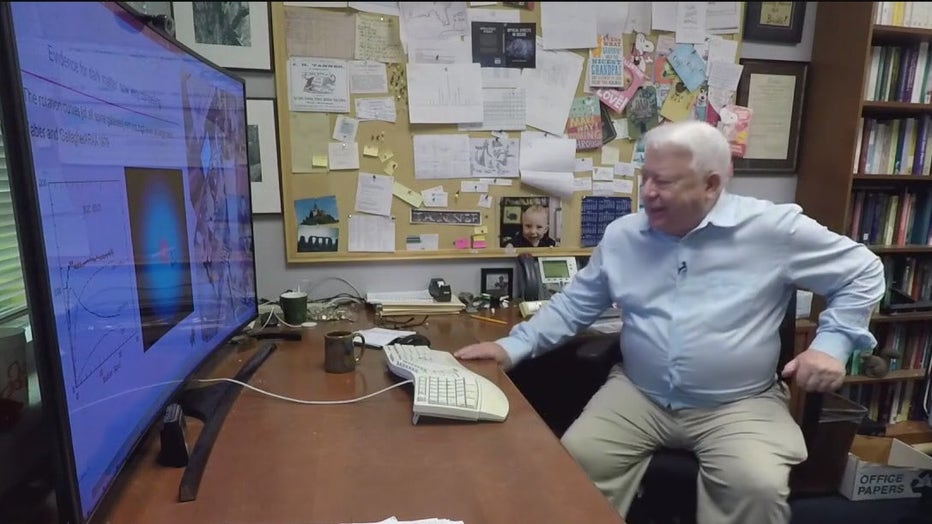UF and the search for dark matter
TAMPA - The University of Florida may be closing in on the discovery of a lifetime. For decades, UF has led much of the world in the search for dark matter. It has partnered with other leading researchers to solve one of the greatest mysteries in physics.
For context, we can determine the mass of distant galaxies- and precisely calculate their spin. Yet, we can also see those same galaxies spinning much faster than the laws of physics should allow.
"They are not behaving anything like we expect they should," said University of Florida Physics Professor Dr. Jeff Dror. "They should obey Newton’s laws. Newton’s laws have held up so well (up to small corrections Einstein showed us), and they are not obeying those laws at all. And the fact they’re not obeying those laws suggests there’s something out there we’re just not seeing."
It's also bending and warping light from distant galaxies which tells us there must be huge clumps of matter along the way that we can't perceive. Since we're in the dark as to what it is, we call it dark matter. Meanwhile, we know the universe is expanding. But instead of gravity slowing down the expansion (because gravity attracts things back toward one another) we discovered the expansion is inexplicably speeding up.
OTHER BREAKTHROUGH IN SCIENCE STORIES
- UCF collaborates on breakthrough in fighting cancer
- UCF develops breakthrough in hypersonic propulsion
"It’s accelerating and that’s the dark energy content, which is even more mysterious," said UF Physics Professor Dr. David Tanner.
Tanner is one of the world's top experts in the search for dark matter, globally recognized for his work. He co-founded UF's dark matter initiative more than 40 years ago and helped design the devices that are looking for it today.
"It’s never been detected, but the theoretical components have been pretty much worked out," he said.
Mathematically, most of the universe is made up of a lot of things we cannot perceive but must have been around since the beginning of time. Gravity and Math reveal the observable universe is mostly comprised of dark energy and dark matter.
UF Graduate student David Sadek is looking for one type called a Weakly interacting Mass Particle (or WIMP).
"This experiment is very sensitive, so it is currently located underground in a snow lab of Ontario, Canada," Sadek said.
Meanwhile, Tanner helped develop axion detectors.

Axions are a different type of theoretical dark matter. University of Florida launched the experiment called ADMX, which stands for Axion Dark Matter eXperiment. It expanded into an international partnership with the hub now based at the University of Washington.
"An axion is a particle which is a candidate for dark energy, it could be a candidate for dark matter and that’s what drives a lot of work here in the ADMX collaboration," said Dror.
Based on complex math and physics, if axions exist as equations suggest and scientists suspect, they will release photons when they decay, and a strong magnetic field would stimulate their decay. Therefore, ADMX uses powerful magnets to stimulate an axion's decay, and they position microwave cavities with superconducting amplifiers to catch the photon release. To detect that little extra power coming out of the cylinder or cavity, you must tune it to the right frequency. That's the real trick, because we don't know yet know what an axion's specific frequency would be.
"Exactly. It’s like driving through the desert in the middle of the night and you’re trying to find an AM radio station so you can stay awake," said Tanner "You tune. You hear nothing but static. You tune and hear nothing but static. You tune (and then) you hear a very weak voice, but you’ve found a radio station."
By Tanner’s analogy, when you find the station, you hit the jackpot and finally clean up the problem in physics.
"There’s only one frequency that works. It’s not more than one station and the possibilities are many, and we’ve been slowly tuning along," said Tanner who predicted axions could be detected within the next ten years as they expand ADMX.
SIGN UP: Click here to sign up for the FOX 13 daily newsletter
UF Graduate student Alex Hipp is working on the model of what they'll build on a much larger scale at the Department of Energy's Fermilab near Chicago.
"It would be the high point of my life probably, one of the biggest discoveries in physics probably for the coming century," said Hipp.
For example, detecting a high number of Axions could provide observable experiments to help nail down string theory which holds there are actually 10 or 11 dimensions of existence, though we can only perceive the dimensions of length, width, height (and the passage of time).
"If indeed we start finding many axions in our experiments, the only explanation I could think of is that it’s a consequence of string theory," Dror noted.
The detection of Axions could help us pinpoint a theory of everything while the technology used in these devices could help spin off the age of ultrafast quantum computers.
"And now they're applying it to the growing field of quantum information and quantum computing, because once you have a device to this people say that’s great. I can use it for this application," said UF Physics Professor Dr. Tarek Saab.

